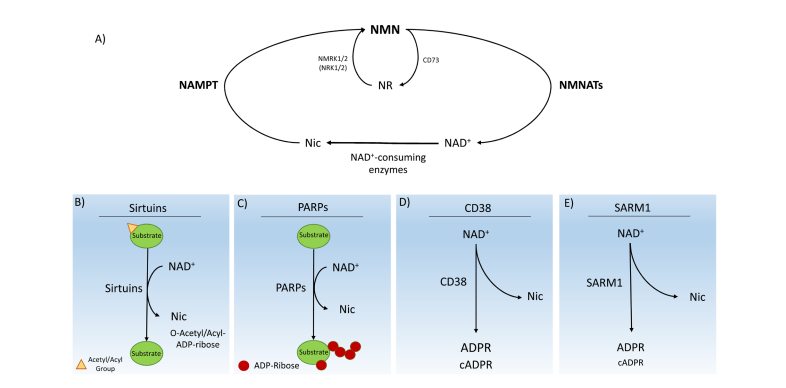[学术文献]NAD+生物合成、衰老和疾病
原文标题:NAD+ biosynthesis, aging, and disease [version 1; referees: 2 approved]
NAD+生物合成、衰老和疾病【PDF在线阅读/下载】
原文简介:
Abstract
Nicotinamide adenine dinucleotide (NAD+) biosynthesis and its regulation have recently been attracting markedly increasing interest. Aging is marked by a systemic decrease in NAD+ across multiple tissues. The dysfunction of NAD+
biosynthesis plays a critical role in the pathophysiologies of multiple diseases, including age-associated metabolic disorders, neurodegenerative diseases, and mental disorders. As downstream effectors, NAD+-dependent enzymes, such as sirtuins, are involved in the progression of such disorders. These recent studies implicate NAD biosynthesis as a potential target for preventing
and treating age-associated diseases. Indeed, new studies have demonstrated the therapeutic potential of supplementing NAD+ intermediates, such as nicotinamide mononucleotide and nicotinamide riboside, providing a proof of concept for the development of an effective anti-aging intervention.
Corresponding author: Shin–ichiro Imai (imaishin@wustl.edu) Author roles: Johnson S: Conceptualization, Writing – Original Draft Preparation, Writing – Review & Editing; Imai S: Conceptualization, Funding Acquisition, Project Administration, Supervision, Writing – Original Draft Preparation, Writing – Review & Editing Competing interests: No competing interests were disclosed. How to cite this article: Johnson S and Imai S. NAD + biosynthesis, aging, and disease [version 1; referees: 2 approved] F1000Research 2018, 7(F1000 Faculty Rev):132 (doi: 10.12688/f1000research.12120.1) Copyright: © 2018 Johnson S and Imai S. This is an open access article distributed under the terms of the Creative Commons Attribution Licence, which permits unrestricted use, distribution, and reproduction in any medium, provided the original work is properly cited. Grant information: SI is supported by grants from the National Institute on Aging (AG037457 and AG047902), the American Federation for Aging Research, and the Tanaka Fund. The funders had no role in study design, data collection and analysis, decision to publish, or preparation of the manuscript. First published: 01 Feb 2018, 7(F1000 Faculty Rev):132 (doi: 10.12688/f1000research.12120.1)
NAD+生物合成、衰老和疾病【PDF在线阅读/下载】
原文简介:
Abstract
Nicotinamide adenine dinucleotide (NAD+) biosynthesis and its regulation have recently been attracting markedly increasing interest. Aging is marked by a systemic decrease in NAD+ across multiple tissues. The dysfunction of NAD+
biosynthesis plays a critical role in the pathophysiologies of multiple diseases, including age-associated metabolic disorders, neurodegenerative diseases, and mental disorders. As downstream effectors, NAD+-dependent enzymes, such as sirtuins, are involved in the progression of such disorders. These recent studies implicate NAD biosynthesis as a potential target for preventing
and treating age-associated diseases. Indeed, new studies have demonstrated the therapeutic potential of supplementing NAD+ intermediates, such as nicotinamide mononucleotide and nicotinamide riboside, providing a proof of concept for the development of an effective anti-aging intervention.

Corresponding author: Shin–ichiro Imai (imaishin@wustl.edu) Author roles: Johnson S: Conceptualization, Writing – Original Draft Preparation, Writing – Review & Editing; Imai S: Conceptualization, Funding Acquisition, Project Administration, Supervision, Writing – Original Draft Preparation, Writing – Review & Editing Competing interests: No competing interests were disclosed. How to cite this article: Johnson S and Imai S. NAD + biosynthesis, aging, and disease [version 1; referees: 2 approved] F1000Research 2018, 7(F1000 Faculty Rev):132 (doi: 10.12688/f1000research.12120.1) Copyright: © 2018 Johnson S and Imai S. This is an open access article distributed under the terms of the Creative Commons Attribution Licence, which permits unrestricted use, distribution, and reproduction in any medium, provided the original work is properly cited. Grant information: SI is supported by grants from the National Institute on Aging (AG037457 and AG047902), the American Federation for Aging Research, and the Tanaka Fund. The funders had no role in study design, data collection and analysis, decision to publish, or preparation of the manuscript. First published: 01 Feb 2018, 7(F1000 Faculty Rev):132 (doi: 10.12688/f1000research.12120.1)

